
- The Contents
- The Making of
- Where Are They Now
- Frequently Asked Questions
- Q & A with Ed Stone

golden record
Where are they now.
- frequently asked questions
- Q&A with Ed Stone
Galleries of Images Voyager Took
The Voyager 1 and 2 spacecraft explored Jupiter, Saturn, Uranus and Neptune before starting their journey toward interstellar space. Here you'll find some of those iconic images, including "The Pale Blue Dot" - famously described by Carl Sagan - and what are still the only up-close images of Uranus and Neptune.
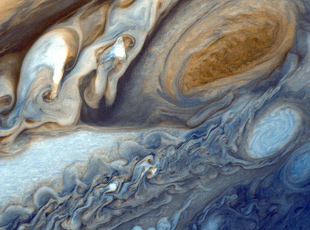
Photography of Jupiter began in January 1979, when images of the brightly banded planet already exceeded the best taken from Earth. Voyager 1 completed its Jupiter encounter in early April, after taking almost 19,000 pictures and many other scientific measurements. Voyager 2 picked up the baton in late April and its encounter continued into August. They took more than 33,000 pictures of Jupiter and its five major satellites.
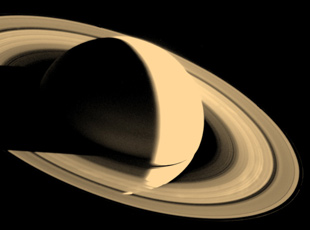
The Voyager 1 and 2 Saturn encounters occurred nine months apart, in November 1980 and August 1981. Voyager 1 is leaving the solar system. Voyager 2 completed its encounter with Uranus in January 1986 and with Neptune in August 1989, and is now also en route out of the solar system.
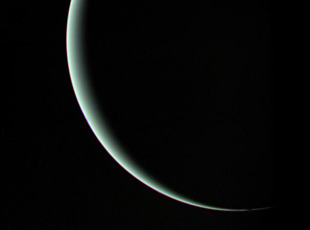
NASA's Voyager 2 spacecraft flew closely past distant Uranus, the seventh planet from the Sun, in January. At its closet, the spacecraft came within 81,800 kilometers (50,600 miles) of Uranus's cloudtops on Jan. 24, 1986. Voyager 2 radioed thousands of images and voluminous amounts of other scientific data on the planet, its moons, rings, atmosphere, interior and the magnetic environment surrounding Uranus.
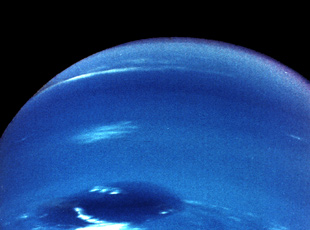
In the summer of 1989, NASA's Voyager 2 became the first spacecraft to observe the planet Neptune, its final planetary target. Passing about 4,950 kilometers (3,000 miles) above Neptune's north pole, Voyager 2 made its closest approach to any planet since leaving Earth 12 years ago. Five hours later, Voyager 2 passed about 40,000 kilometers (25,000 miles) from Neptune's largest moon, Triton, the last solid body the spacecraft will have an opportunity to study.
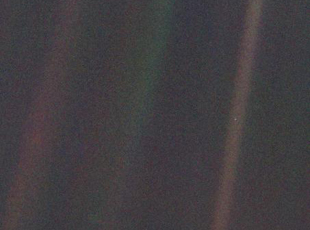
This narrow-angle color image of the Earth, dubbed 'Pale Blue Dot', is a part of the first ever 'portrait' of the solar system taken by Voyager 1. The spacecraft acquired a total of 60 frames for a mosaic of the solar system from a distance of more than 4 billion miles from Earth and about 32 degrees above the ecliptic. From Voyager's great distance Earth is a mere point of light, less than the size of a picture element even in the narrow-angle camera. Earth was a crescent only 0.12 pixel in size. Coincidentally, Earth lies right in the center of one of the scattered light rays resulting from taking the image so close to the sun. This blown-up image of the Earth was taken through three color filters -- violet, blue and green -- and recombined to produce the color image. The background features in the image are artifacts resulting from the magnification.
- Become A Member
- Gift Membership
- Kids Membership
- Other Ways to Give
- Explore Worlds
- Defend Earth
How We Work
- Education & Public Outreach
- Space Policy & Advocacy
- Science & Technology
- Global Collaboration
Our Results
Learn how our members and community are changing the worlds.
Our citizen-funded spacecraft successfully demonstrated solar sailing for CubeSats.
Space Topics
- Planets & Other Worlds
- Space Missions
- Space Policy
- Planetary Radio
- Space Images
The Planetary Report
The eclipse issue.
Science and splendor under the shadow.
Get Involved
Membership programs for explorers of all ages.
Get updates and weekly tools to learn, share, and advocate for space exploration.
Volunteer as a space advocate.
Support Our Mission
- Renew Membership
- Society Projects
The Planetary Fund
Accelerate progress in our three core enterprises — Explore Worlds, Find Life, and Defend Earth. You can support the entire fund, or designate a core enterprise of your choice.
- Strategic Framework
- News & Press
The Planetary Society
Know the cosmos and our place within it.
Our Mission
Empowering the world's citizens to advance space science and exploration.
- Explore Space
- Take Action
- Member Community
- Account Center
- “Exploration is in our nature.” - Carl Sagan
Rae Paoletta • Mar 03, 2022
The best space pictures from the Voyager 1 and 2 missions
Launched in 1977, NASA’s Voyager 1 and 2 missions provided an unprecedented glimpse into the outer solar system — a liminal space once left largely to the imagination. The spacecraft provided views of worlds we’d never seen before, and in some cases, haven’t seen much of since.
The Voyager probes were launched about two weeks apart and had different trajectories, like two tour guides at the same museum. Only Voyager 2 visited the ice giants — Uranus and Neptune — for example.
The Voyagers hold a unique position in the pantheon of space history because they’re still making it; even right now, Voyagers 1 and 2 are the only functioning spacecraft in interstellar space. Both hold a Golden Record that contains sights and sounds of Earth in case alien life were to find one of the spacecraft.
As the Voyager missions voyage on, it’s good to look back at how they captured our solar system before leaving it.
This content is hosted by a third party (youtube.com), which uses marketing cookies. Please accept marketing cookies to watch this video.
Let’s Go Beyond The Horizon
Every success in space exploration is the result of the community of space enthusiasts, like you, who believe it is important. You can help usher in the next great era of space exploration with your gift today.
For full functionality of this site it is necessary to enable JavaScript. Here are instructions on how to enable JavaScript in your web browser .

First-Ever Solar System Family Portrait (1990)
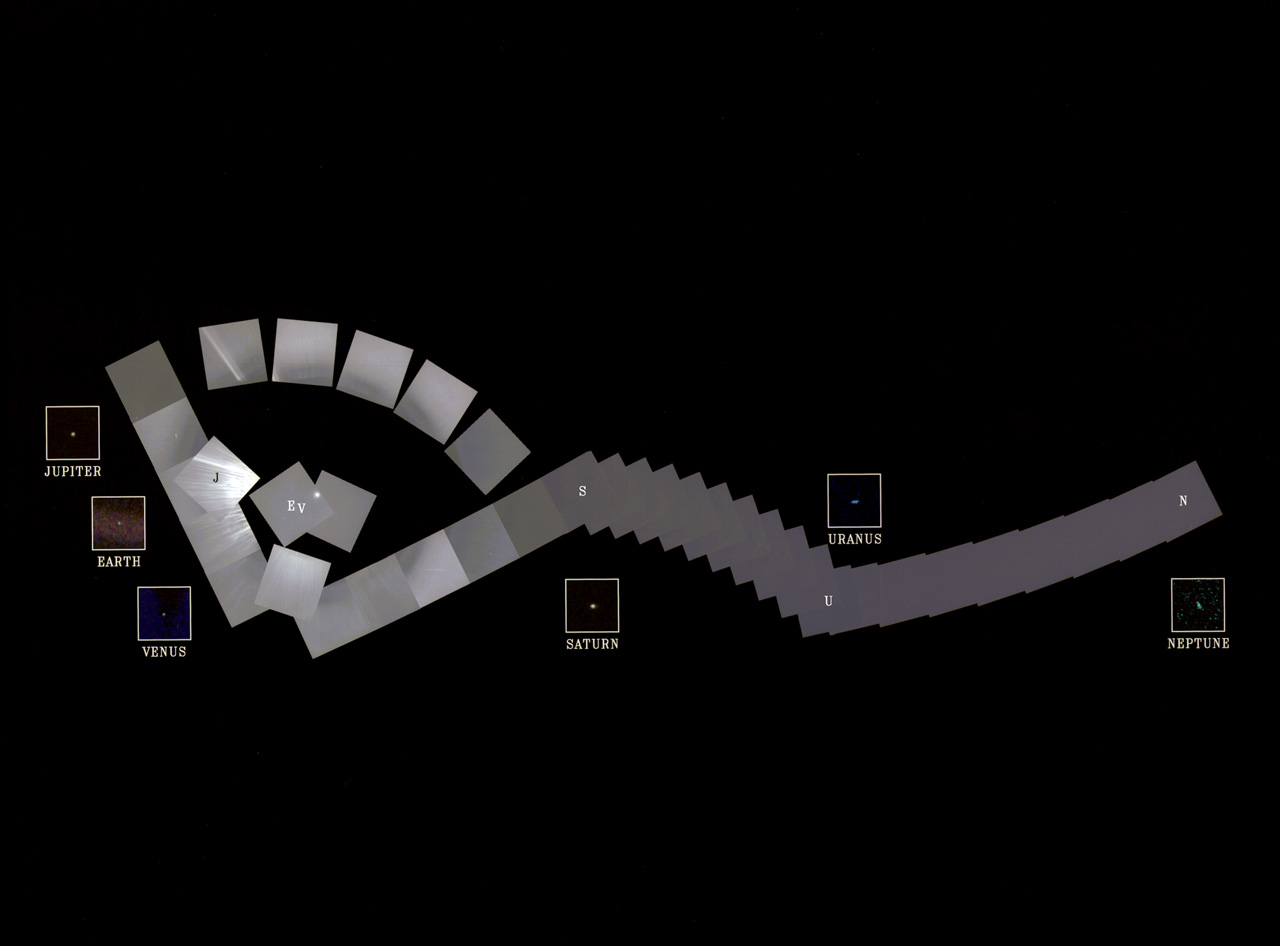
The Solar System "family portrait" is the final series of 60 images captured by NASA's Voyager 1 that show six of our solar system's planets. It remains the first and only time — so far — a spacecraft has attempted to photograph our home solar system. Only three spacecraft have been capable of making such an observation from such a distance: Voyager 1, Voyager 2 and New Horizons.
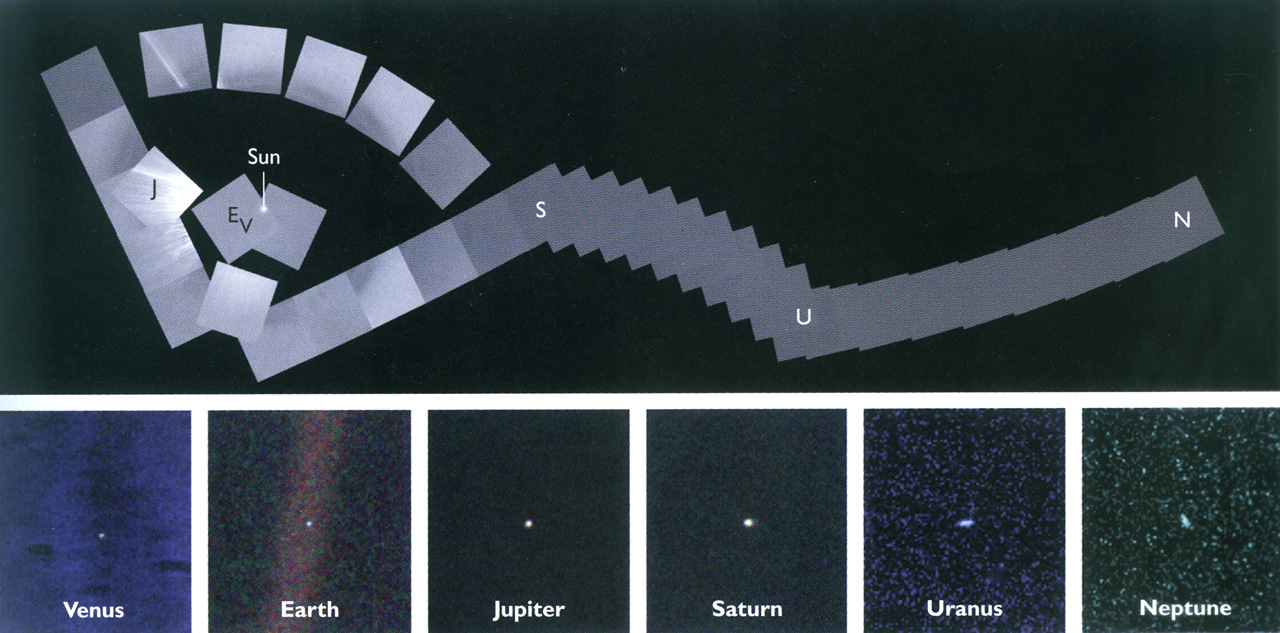
The Family Portrait
In February 1990, Voyager 1 was speeding out of the solar system — beyond Neptune and about 3.7 billion miles (6 billion kilometers) from the Sun — when mission managers commanded it to look back toward home for a final time. It snapped a series of 60 images that were used to create the first “family portrait” of our solar system.
The image series contatains the famous image that would become known as the Pale Blue Dot, revealing Earth was a tiny dot within a scattered ray of sunlight. Voyager 1 was so far away that — from its vantage point — Earth was a crescent about a pixel.
In addition to Earth, Voyager 1 captured images of Neptune, Uranus, Saturn, Jupiter, and Venus. Mars was obscured by scattered sunlight bouncing around in the camera and Mercury was too close to the Sun, and dwarf planet Pluto was too tiny, too far away and too dark to be detected.
The images gave humans an awe-inspiring and unprecedented view of their home world and its neighbors. Like Earth, each planet appears as just a speck of light (Uranus and Neptune appear elongated due to spacecraft motion during their 15-second camera exposures).
"The family portrait is a symbol what NASA exploration is really about: Seeing our world in a new and bigger way," Dr. Thomas H. Zurbuchen, Associate Administrator of NASA's Science Mission Directorate, said in 2018.
The family portrait remains the first and only time a spacecraft has attempted to photograph our home solar system. Only three spacecraft have been capable of making such an observation from such a distance: Voyager 1, Voyager 2 and New Horizons.
About the Photographer
Voyager 1 was launched Sept. 5, 1977, just days after its twin — Voyager 2 — on Aug. 20. Because it was on a faster route to the mission's first encounter, at Jupiter, Voyager 1 overtook Voyager 2 on Dec. 15, 1977. (This was the reason for the order of their naming.)
Voyager 1 flew past Jupiter on March 5, 1979, and Saturn on Nov. 12, 1980.
After snapping the Pale Blue Dot and other “family photos,” — at 05:22 GMT, Feb. 14, 1990 — Voyager 1 powered off its cameras forever. Mission planners wanted to save its energy for the long journey ahead.
In August 2012, Voyager 1 entered interstellar space . It’s now the most distant human-made object ever.
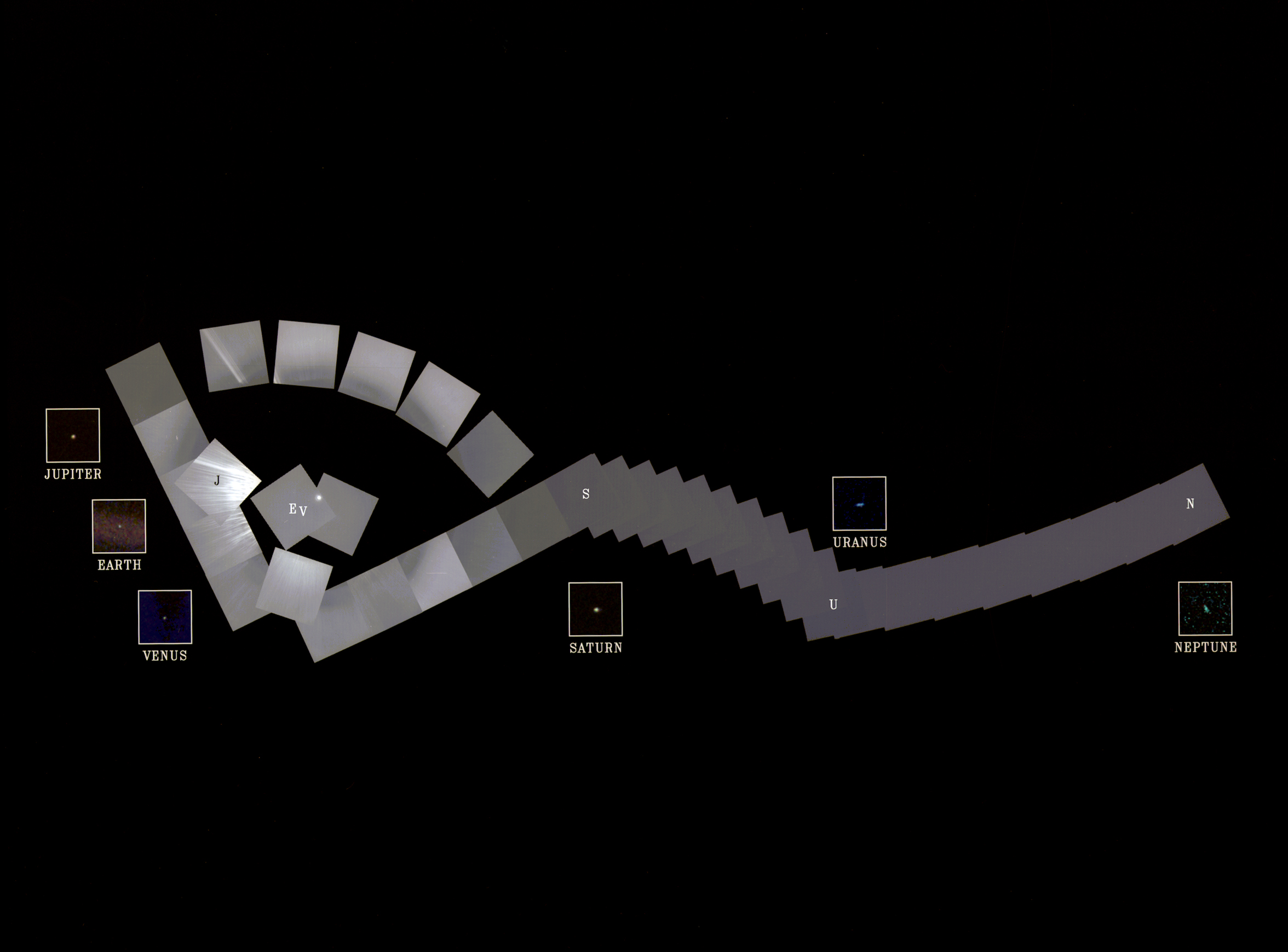
Sep 4, 2023
jpg (827.35 KB)
Highest-Resolution
tif (11.72 MB)
Enlarged Planets
tif (11.20 MB)
- The Inventory
Support Quartz
Fund next-gen business journalism with $10 a month
Free Newsletters
Let’s take a moment to look at the mesmerizing images from Voyager 1
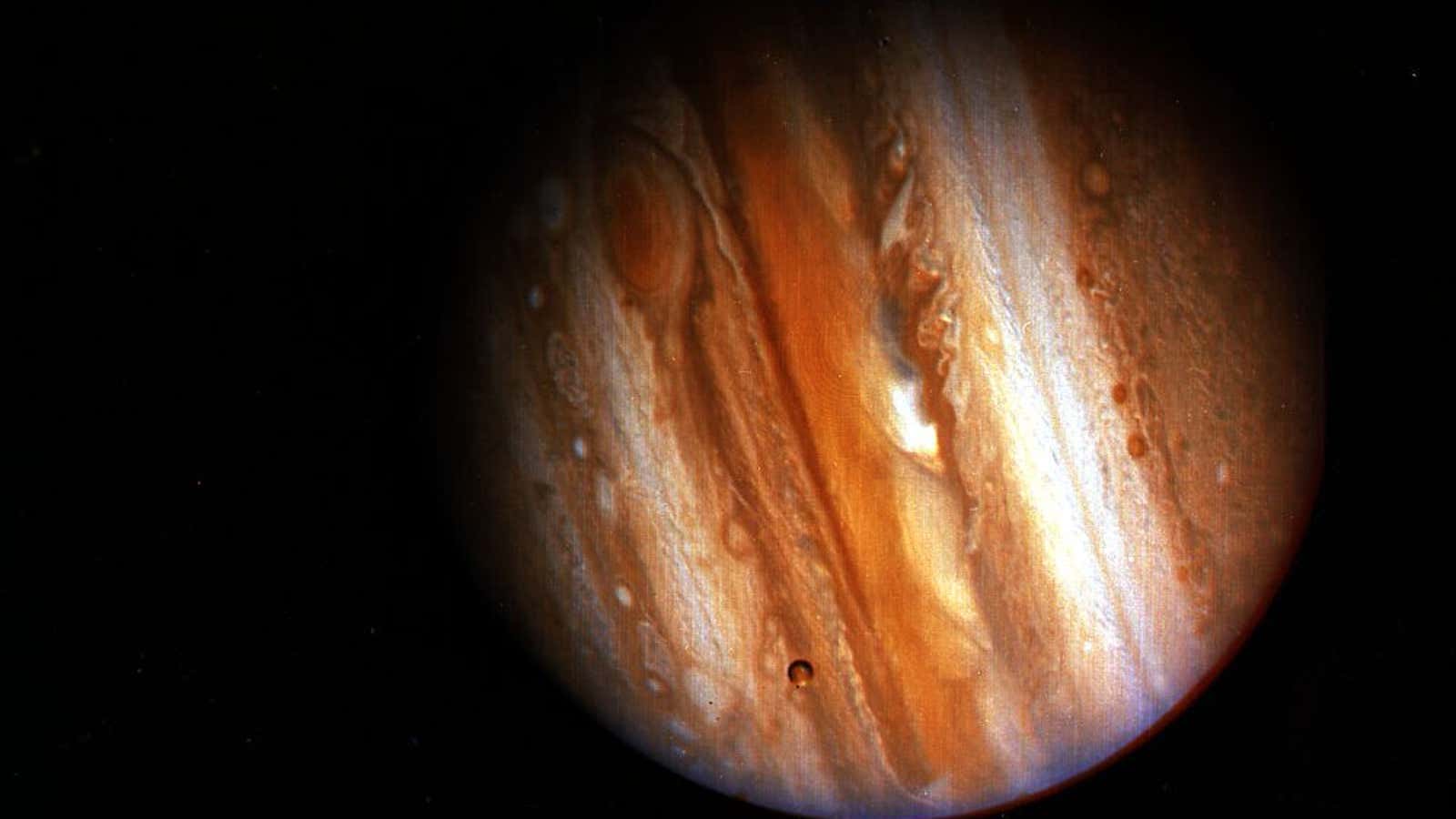
In 1977, NASA launched two Voyager probes, equipped with golden records describing human accomplishment, on a mission to explore the farthest reaches of the solar system. Each record catalogued our music, our greetings, our art and photography.
Forty years later, both spacecrafts are still hurtling through space , exploring parts of the universe where nothing from Earth has visited before. Voyager 1 is now in interstellar space, 13 billion miles away from Earth. Voyager 2 is passing through the heliosheath, the outermost layer of the heliosphere, before it, too, reaches interstellar space.
Last week, in an amazing feat of engineering, NASA engineers turned on Voyager 1’s backup thrusters after they’d been dormant for 37 years. The thrusters will help reorient the spacecraft’s antenna back to Earth, so we can receive its signal for just a little longer.
It’s a fine moment to reflect on the incredible images Voyager 1 has sent back over its lifetime. The probe gave us the first “ portrait ” of our solar system, and memorably mesmerizing shots of Saturn and Jupiter.
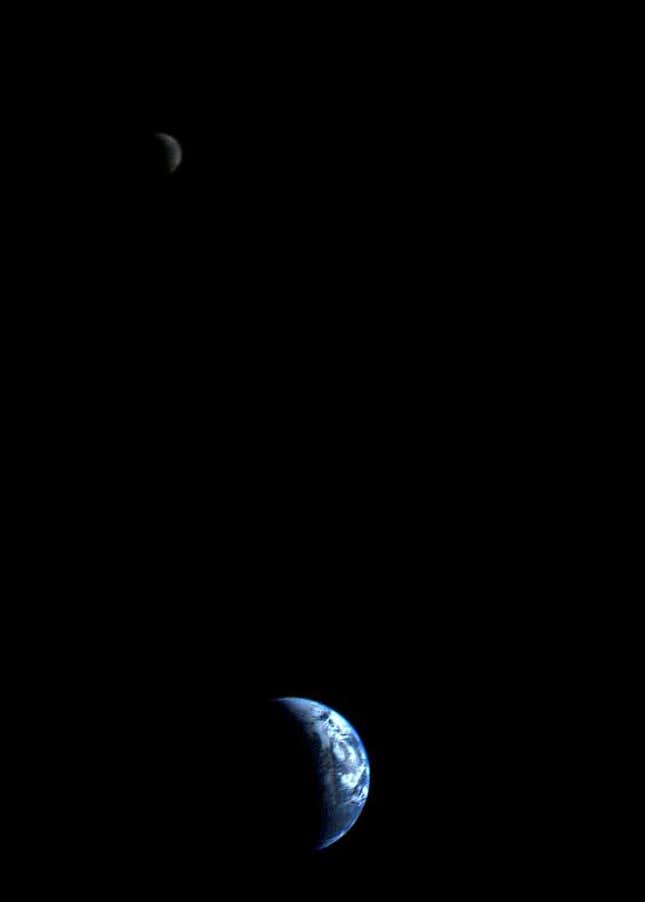
Watch NASA’s moving compilation of images from both Voyagers below:
📬 Sign up for the Daily Brief
Our free, fast, and fun briefing on the global economy, delivered every weekday morning.

Suggested Searches
- Climate Change
- Expedition 64
- Mars perseverance
- SpaceX Crew-2
- International Space Station
- View All Topics A-Z
Humans in Space
Earth & climate, the solar system, the universe, aeronautics, learning resources, news & events.

NASA’s PACE Data on Ocean, Atmosphere, Climate Now Available

Altitude Chamber Gets Upgrade for Artemis II, Spacecraft Testing Begins

NASA Next-Generation Solar Sail Boom Technology Ready for Launch
- Search All NASA Missions
- A to Z List of Missions
- Upcoming Launches and Landings
- Spaceships and Rockets
- Communicating with Missions
- James Webb Space Telescope
- Hubble Space Telescope
- Why Go to Space
- Astronauts Home
- Commercial Space
- Destinations
- Living in Space
- Explore Earth Science
- Earth, Our Planet
- Earth Science in Action
- Earth Multimedia
- Earth Science Researchers
- Pluto & Dwarf Planets
- Asteroids, Comets & Meteors
- The Kuiper Belt
- The Oort Cloud
- Skywatching
- The Search for Life in the Universe
- Black Holes
- The Big Bang
- Dark Energy & Dark Matter
- Earth Science
- Planetary Science
- Astrophysics & Space Science
- The Sun & Heliophysics
- Biological & Physical Sciences
- Lunar Science
- Citizen Science
- Astromaterials
- Aeronautics Research
- Human Space Travel Research
- Science in the Air
- NASA Aircraft
- Flight Innovation
- Supersonic Flight
- Air Traffic Solutions
- Green Aviation Tech
- Drones & You
- Technology Transfer & Spinoffs
- Space Travel Technology
- Technology Living in Space
- Manufacturing and Materials
- Science Instruments
- For Kids and Students
- For Educators
- For Colleges and Universities
- For Professionals
- Science for Everyone
- Requests for Exhibits, Artifacts, or Speakers
- STEM Engagement at NASA
- NASA's Impacts
- Centers and Facilities
- Directorates
- Organizations
- People of NASA
- Internships
- Our History
- Doing Business with NASA
- Get Involved
- Aeronáutica
- Ciencias Terrestres
- Sistema Solar
- All NASA News
- Video Series on NASA+
- Newsletters
- Social Media
- Media Resources
- Upcoming Launches & Landings
- Virtual Events
- Sounds and Ringtones
- Interactives
- STEM Multimedia

The April 8 Total Solar Eclipse: Through the Eyes of NASA

NASA’s Boeing Crew Flight Test Mission Overview

Hubble Spots a Galaxy Hidden in a Dark Cloud

NASA Shares Medical Expertise with New Space Station Partners

From NASA’s First Astronaut Class to Artemis II: The Importance of Military Jet Pilot Experience

The Ocean Touches Everything: Celebrate Earth Day with NASA

Earth Day Poster 2024
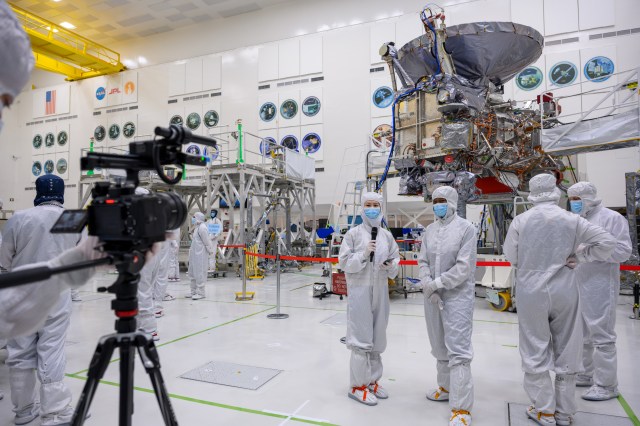
Media Get Close-Up of NASA’s Jupiter-Bound Europa Clipper

More Than 36,000 Volunteers Helped Do NASA Eclipse Science

NASA’s TESS Temporarily Pauses Science Observations

NASA Names Finalists of the Power to Explore Challenge
Earth Day 2024: Posters and Virtual Backgrounds

NASA Langley Team to Study Weather During Eclipse Using Uncrewed Vehicles

ARMD Solicitations

NASA Noise Prediction Tool Supports Users in Air Taxi Industry

Tech Today: Folding NASA Experience into an Origami Toolkit

NASA’s SERT II: ‘A Genuine Space Success Story’

NASA Partnerships Bring 2024 Total Solar Eclipse to Everyone

Shawnta M. Ball Turns Obstacles into Opportunities in Goddard’s Education Office

A Langley Intern Traveled 1,340 Miles to View a Total Solar Eclipse. Here’s What She Saw.

La presentación del X-59 de la NASA personifica la tradición aeronáutica
Voyager 1 takes the first image of the earth-moon system in a single frame.

Voyager 1 snapped this picture from a distance of 7.25 million miles. It was the first to include both the Earth and the Moon in a single frame taken by a spacecraft.
Voyager 1 to Take Pictures of Solar System Planets

NASA's Voyager 1 spacecraft, having completed its mission along with Voyager 2 to explore the outer planets, will use its cameras February 13-14 to take an unprecedented family portrait of most of the planets in our solar system.
The collection of images will be from a unique point-of-view -- looking down on the solar system from a position 32 degrees above the ecliptic plane in which the planets orbit the Sun. No other spacecraft has ever been in a position to attempt a similar series of photos of most of the planets.
Voyager 1, launched in 1977, is now about 6 billion kilometers (3.7 billion miles) from Earth. The Voyager spacecraft are controlled by and their data received at the Jet Propulsion Laboratory, Pasadena, Calif.
"This is not just the first time, but perhaps the only time for decades that we'll be able to take a picture of the planets from outside the solar system," said Voyager Project Scientist Dr. Edward C. Stone of Caltech. No future space missions are planned that would fly a spacecraft so high above the ecliptic plane of the solar system, he said.
Starting shortly after 5 p.m. (PST) on Feb. 13 and continuing over the course of four hours, Voyager 1 will point its wide- and narrow-angle cameras at Neptune, Uranus, Saturn, Jupiter, Mars, Earth and Venus. Mercury is too close to the Sun to be photographed by Voyager's cameras, and Pluto is too far away and too small to show up in images taken by the spacecraft. Beginning with the dimmest of the targets - Neptune -- and working toward the Sun, Voyager 1 will shutter about 64 images of the planets and the space between them.
The constellation Eridanus (The River), stretching behind the planets from Voyager 1's perspective, will provide the backdrop for the images.
Due to the schedules of several spacecraft being tracked by NASA's Deep Space Network (DSN), the images will be recorded on board Voyager 1 and played back to DSN receivers on Earth in late March. The Voyager imaging team estimates that processing the images to reveal as much detail as possible will take several weeks. Most of the planets will appear as relatively small dots (about one to four pixels, or picture elements, in the 800-by-800 pixel frame of one Voyager image).
The enormous scale of the subject matter makes it unlikely that the entire set of images can be mosaicked to produce for publication a single photograph showing all the planets. Even an image covering the planets out to Jupiter would easily fill a poster-sized photographic print. At the least, imaging team hopes to assemble a mosaicked image composed of the frames showing Earth, Venus and perhaps Mars together.
Voyager 1, rather than Voyager 2, received the solar system photo assignment largely because of Voyager 1's improved viewpoint of the planets.
Voyager 1 completed flybys of Jupiter and Saturn in 1979 and 1980, respectively. Voyager 2 flew past Jupiter in 1979, Saturn in 1981, Uranus in 1986 and Neptune last August. Both are now on missions that will take the spacecraft to the boundary of our solar system and into interstellar space.
According to Voyager engineers and scientists, the only potential damage from pointing the cameras toward the Sun is that the shutter blades of the wide-angle camera might warp. There are no plans, however, to use Voyager 1's cameras after the solar system photo series is completed.
The Voyager mission is conducted by Caltech's JPL for NASA's Office of Space Science and Applications.
NASA engineers discover why Voyager 1 is sending a stream of gibberish from outside our solar system
Voyager 1 has been sending a stream of garbled nonsense since November. Now NASA engineers have identified the fault and found a potential workaround.
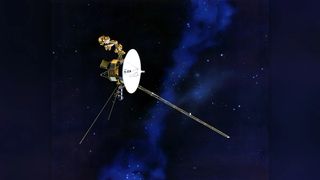
For the past five months, the Voyager 1 spacecraft has been sending a steady stream of unreadable gibberish back to Earth. Now, NASA engineers finally know why.
The 46-year-old spacecraft sends regular radio signals as it drifts further from our solar system . But in November 2023, the signals suddenly became garbled, meaning scientists were unable to read any of its data, and they were left mystified about the fault's origins.
In March, NASA engineers sent a command prompt, or "poke," to the craft to get a readout from its flight data subsystem (FDS) — which packages Voyager 1's science and engineering data before beaming it back to Earth.
After decoding the spacecraft's response, the engineers have found the source of the problem: The FDS's memory has been corrupted.
Related: NASA's Voyager 1 sends readable message to Earth after 4 nail-biting months of gibberish
"The team suspects that a single chip responsible for storing part of the affected portion of the FDS memory isn't working," NASA said in a blog post Wednesday (March 13) . "Engineers can't determine with certainty what caused the issue. Two possibilities are that the chip could have been hit by an energetic particle from space or that it simply may have worn out after 46 years."
— NASA hears 'heartbeat' signal from Voyager 2 probe a week after losing contact
— Historic space photo of the week: Voyager 2 spies a storm on Saturn 42 years ago
— NASA reestablishes full contact with Voyager 2 probe after nail-biting 2-week blackout
Although it may take several months, the engineers say they can find a workaround to run the FDS without the fried chip — restoring the spacecraft's messaging output and enabling it to continue to send readable information from outside our solar system.
Sign up for the Live Science daily newsletter now
Get the world’s most fascinating discoveries delivered straight to your inbox.
Launched in 1977, Voyager 1 zipped past Saturn and Jupiter in 1979 and 1980 before flying out into interstellar space in 2012. It is now recording the conditions outside of the sun's protective magnetic field , or heliosphere, which blankets our solar system.
Voyager 1 is currently more than 15 billion miles (24 billion kilometers) from Earth, and it takes 22.5 hours for any radio signal to travel from the craft to our planet.

Ben Turner is a U.K. based staff writer at Live Science. He covers physics and astronomy, among other topics like tech and climate change. He graduated from University College London with a degree in particle physics before training as a journalist. When he's not writing, Ben enjoys reading literature, playing the guitar and embarrassing himself with chess.
NASA spacecraft snaps mysterious 'surfboard' orbiting the moon. What is it?
The moon is getting its own time zone, White House memo to NASA reveals
Exercise may reverse sign of aging by 'flushing' fat from muscle
- TorbjornLarsson Bon voyage, Voyager! Reply
- Jay McHue What if aliens are doing it to try to communicate with us? 🤪 Reply
Jay McHue said: What if aliens are doing it to try to communicate with us? 🤪
admin said: Voyager 1 has been sending a stream of garbled nonsense since November. Now NASA engineers have identified the fault and found a potential workaround. NASA engineers discover why Voyager 1 is sending a stream of gibberish from outside our solar system : Read more
sourloaf said: What does FSB mean?
Rusty Lugnuts said: Where are you seeing "FSB"? The closest thing I can see in the article is "FDS". In modern computers, FSB would most likely refer to the Fr0nt S1ide Bu5, though I have no idea if a system as old as Voyagers, let alone engineered so specifically, would have an FSB. (apparently I can't spell out "Fr0nt S1ide Bu5" or my post gets flagged as spam or inappropriate??)
- SkidWard Just cut the % of ram needed... skip the bad sectors Reply
- kloudykat FDS = fl1ght da1a sub5ystem5 Reply
- 5ft24dave This is pretty old news, like 6 months old. Are you guys just now discovering this? Reply
Commodore Browncoat said: That's about as sane a theory as many of the others that have become ridiculously popular in the past several years, so sure - why not? What reply do you think we should send?
- View All 11 Comments
Most Popular
- 2 Here are the best photos of the April 8 total solar eclipse over North America
- 3 Underwater mountain range off Easter Island hosts creatures unknown to science, expedition reveals
- 4 Uranus and Neptune aren't made of what we thought, new study hints
- 5 Total solar eclipse reveals tiny new comet moments before it was destroyed by the sun
- 2 Uranus and Neptune aren't made of what we thought, new study hints
- 3 Eclipse from space: See the moon's shadow race across North America at 1,500 mph in epic satellite footage
- 4 Largest 3D map of our universe could 'turn cosmology upside down'
- 5 James Webb telescope finds origins of the biggest explosion since the Big Bang — revealing a new cosmological mystery
Advertisement
What Solar Eclipse-Gazing Has Looked Like for the Past 2 Centuries
Millions of people on Monday will continue the tradition of experiencing and capturing solar eclipses, a pursuit that has spawned a lot of unusual gear.
- Share full article

By Sarah Eckinger
- April 8, 2024
For centuries, people have been clamoring to glimpse solar eclipses. From astronomers with custom-built photographic equipment to groups huddled together with special glasses, this spectacle has captivated the human imagination.
Creating a Permanent Record
In 1860, Warren de la Rue captured what many sources describe as the first photograph of a total solar eclipse . He took it in Rivabellosa, Spain, with an instrument known as the Kew Photoheliograph . This combination of a telescope and camera was specifically built to photograph the sun.
Forty years later, Nevil Maskelyne, a magician and an astronomy enthusiast, filmed a total solar eclipse in North Carolina. The footage was lost, however, and only released in 2019 after it was rediscovered in the Royal Astronomical Society’s archives.

Telescopic Vision
For scientists and astronomers, eclipses provide an opportunity not only to view the moon’s umbra and gaze at the sun’s corona, but also to make observations that further their studies. Many observatories, or friendly neighbors with a telescope, also make their instruments available to the public during eclipses.
Fredrik Hjalmar Johansen, Fridtjof Nansen and Sigurd Scott Hansen observing a solar eclipse while on a polar expedition in 1894 .
Women from Wellesley College in Massachusetts and their professor tested out equipment ahead of their eclipse trip (to “catch old Sol in the act,” as the original New York Times article phrased it) to New London, Conn., in 1922.
A group from Swarthmore College in Pennsylvania traveled to Yerbaniz, Mexico, in 1923, with telescopes and a 65-foot camera to observe the sun’s corona .
Dr. J.J. Nassau, director of the Warner and Swasey Observatory at Case School of Applied Science in Cleveland, prepared to head to Douglas Hill, Maine, to study an eclipse in 1932. An entire freight car was required to transport the institution’s equipment.
Visitors viewed a solar eclipse at an observatory in Berlin in the mid-1930s.
A family set up two telescopes in Bar Harbor, Maine, in 1963. The two children placed stones on the base to help steady them.
An astronomer examined equipment for an eclipse in a desert in Mauritania in June 1973. We credit the hot climate for his choice in outfit.

Indirect Light
If you see people on Monday sprinting to your local park clutching pieces of paper, or with a cardboard box of their head, they are probably planning to reflect or project images of the solar eclipse onto a surface.
Cynthia Goulakos demonstrated a safe way to view a solar eclipse , with two pieces of cardboard to create a reflection of the shadowed sun, in Lowell, Mass., in 1970.
Another popular option is to create a pinhole camera. This woman did so in Central Park in 1963 by using a paper cup with a small hole in the bottom and a twin-lens reflex camera.
Amateur astronomers viewed a partial eclipse, projected from a telescope onto a screen, from atop the Empire State Building in 1967 .
Back in Central Park, in 1970, Irving Schwartz and his wife reflected an eclipse onto a piece of paper by holding binoculars on the edge of a garbage basket.
Children in Denver in 1979 used cardboard viewing boxes and pieces of paper with small pinholes to view projections of a partial eclipse.
A crowd gathered around a basin of water dyed with dark ink, waiting for the reflection of a solar eclipse to appear, in Hanoi, Vietnam, in 1995.
Staring at the Sun (or, How Not to Burn Your Retinas)
Eclipse-gazers have used different methods to protect their eyes throughout the years, some safer than others .
In 1927, women gathered at a window in a building in London to watch a total eclipse through smoked glass. This was popularized in France in the 1700s , but fell out of favor when physicians began writing papers on children whose vision was damaged.
Another trend was to use a strip of exposed photographic film, as seen below in Sydney, Australia, in 1948 and in Turkana, Kenya, in 1963. This method, which was even suggested by The Times in 1979 , has since been declared unsafe.
Solar eclipse glasses are a popular and safe way to view the event ( if you use models compliant with international safety standards ). Over the years there have been various styles, including these large hand-held options found in West Palm Beach, Fla., in 1979.
Parents and children watched a partial eclipse through their eclipse glasses in Tokyo in 1981.
Slimmer, more colorful options were used in Nabusimake, Colombia, in 1998.
In France in 1999.
And in Iran and England in 1999.
And the best way to see the eclipse? With family and friends at a watch party, like this one in Isalo National Park in Madagascar in 2001.
- About Amazon (English)
- About Amazon (日本語)
- About Amazon (Français)
- About Amazon (Deutsch)
- Newsroom (Deutsch)
- About Amazon (Italiano)
- About Amazon (Polski)
- About Amazon (Español)
- Press Center (English)
- About Amazon (Português)
11 photos: How Prime Video's 'Fallout' series brings the iconic video game universe to life
- Facebook Share
- Twitter Share
- LinkedIn Share
- Email Share
- Copy Link copied

Lee este artículo en español .
Based on one of the most celebrated video game franchises of all time, Fallout premieres exclusively on Prime Video on April 10 in more than 240 countries and territories worldwide. The ambitious new series from Amazon MGM Studios delivers an imaginative post-apocalyptic world with a gorgeous retro futuristic atmosphere, nuanced characters, and breathtaking settings to explore.
Set in Los Angeles in the year 2296, 219 years after a nuclear apocalypse decimated the planet, Fallout’s narrative follows a small privileged portion of the population dwelling in luxurious underground Vaults (shelters), and the unfortunate souls living above ground on the irradiated surface struggling to survive the violence and lawlessness that plague the inhabitants.
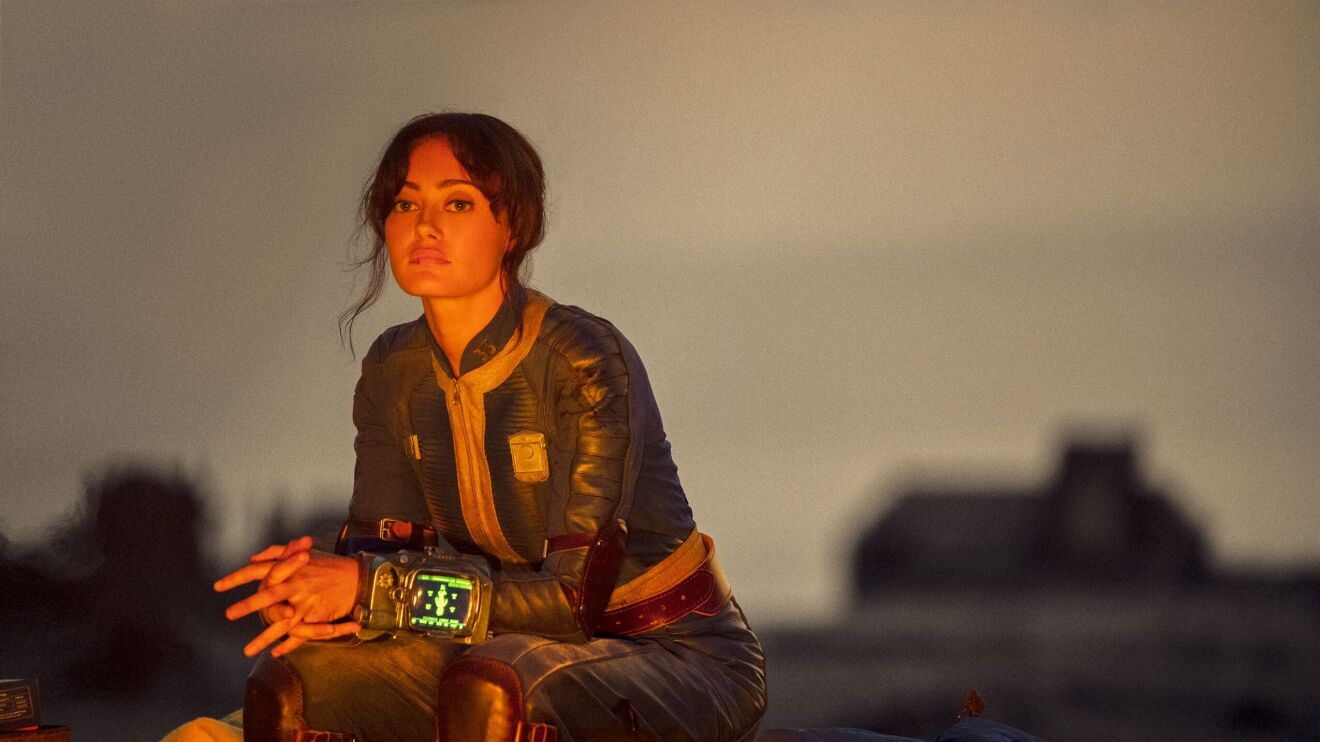
The Fallout video game franchise is one of the most successful titles in the industry, with tens of millions of copies sold worldwide and numerous accolades, including an induction in the Video Game Hall of Fame by Computer Gaming World, and has been hailed as one of the greatest video games of all time by IGN and Polygon.
It was a massive undertaking to bring Fallout’ s expansive story and dynamic world-building from video game consoles to a live-action series on Prime Video. One of the key figures in this development process is executive producer and Bethesda Game Studios’ Todd Howard, who has been a part of the Fallout universe for over a decade as both a Game Director and producer. Howard is one of the most influential figures in gaming. In 2017, he was inducted into the Academy of Interactive Arts & Sciences Hall of Fame and was listed by IGN as one of the Top 100 Game Creators of all time.
“We didn’t want to adapt a specific game,” Howard said. “We wanted to move the timeline forward and tell a new story in the world because the world of Fallout has always been the main character in our games. Partnering with Jonathan Nolan on this and telling a new story helped us bring Fallout’s world to life.”
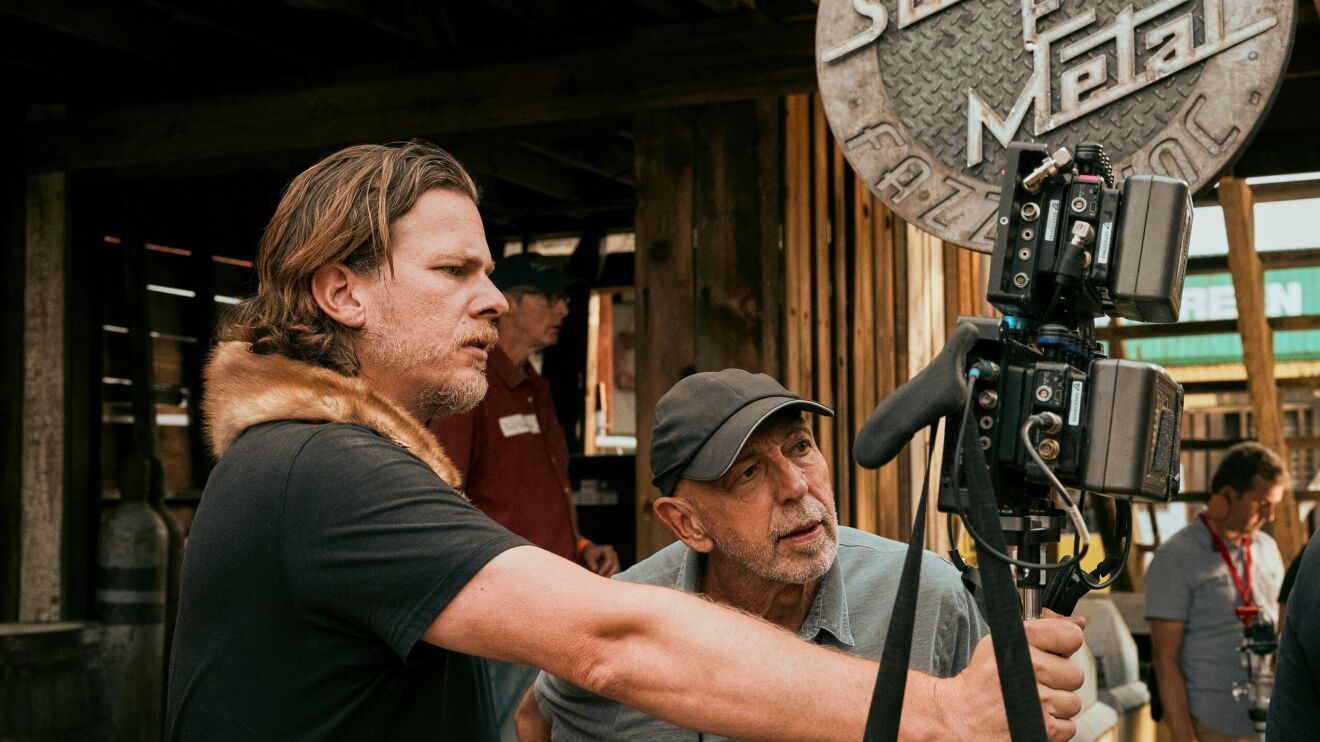
With such a sizeable narrative canvas at their disposal for Fallout’s first season, Howard, executive producer and director Jonathan Nolan ( Batman Begins , Westworld ), and co-showrunners Geneva Robertson-Dworet ( Captain Marvel ) and Graham Wagner ( The Office , Silicon Valley ) discovered that finding the right story to tell was no easy task.
Nolan ( Batman Begins , Westworld ), who also directs Fallout's first three episodes, was instantly captivated by the world after playing Fallout 3 . “I just loved the ambition of it,” Nolan said. “I loved the tone of it. I loved the oddness of it. I loved that you could chart your own course through this world, which was one of the most challenging things to figure out while developing the series. It started for me as a fan of the games, and then I got a chance to sit down with Todd and hear this delicious proposition of taking this incredible universe and figuring out a way to bring it to life on screen. It's just irresistible.”
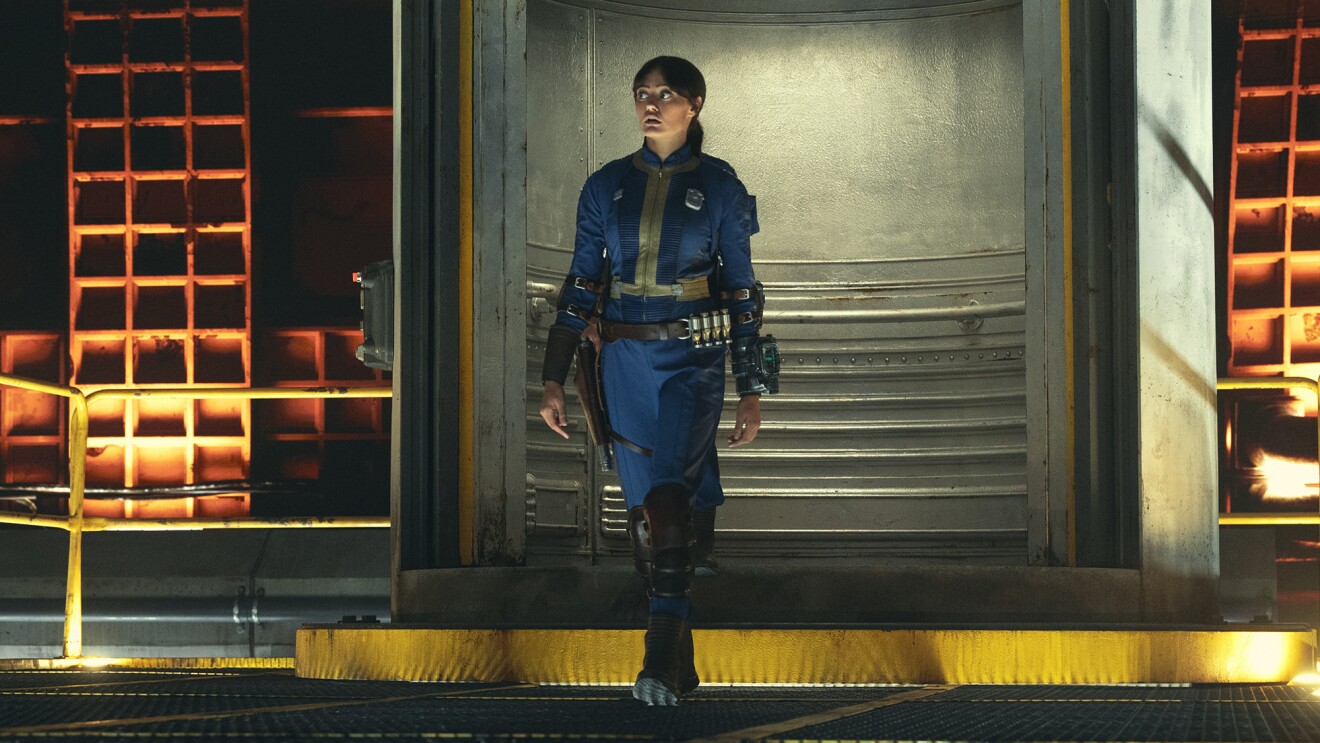
The process of developing a live-action version of Fallout is something that Howard has been considering for over a decade. “I first met with producers in 2009,” Howard said. “Great people, very successful, and I didn't want to do any of that. I just didn't see Fallout translated into a two-hour movie. When prestige television starts coming of age, you start thinking this would be the right approach. This has the time and the literal landscape to do it justice. I love the work that Jonah did in movies like The Dark Knight , and Interstellar , you can see Interstellar all over Starfield , the last game I did, as far as inspiration, and then see Westworld and the other shows that he worked on. Fortunately, we clicked, and it’s been an enjoyable process.”

Co-showrunner Graham Wagner relished the opportunity to work with Howard and his team at Bethesda, who were tremendously helpful in ensuring that the series was as authentic as possible.
“Todd was just such a great collaborator,” Wagner said. “It never felt like he was trying to get in there and force us to do things we didn't want to do. He would just get us to read the scripts and be like, ‘You know what? We got in trouble in that area. Keep an eye on that.’ It was great advice from a guy who's already had similar conversations. That was unbelievably helpful. And then James Altman from Bethesda was on set every day, assuring us that we were getting it right and not accidentally blowing up 25 years of canon. So, if we ever did blow up the canon, we did it with intention.”
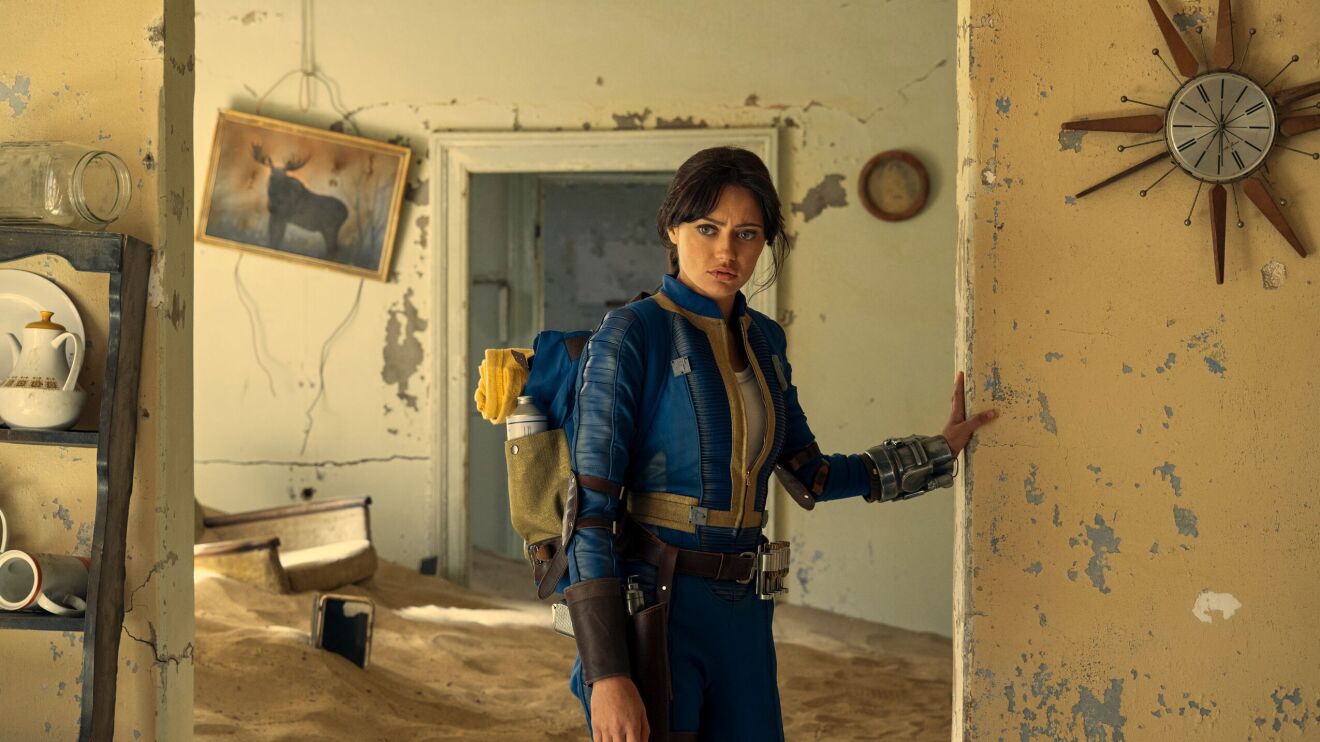
One of Fallout’s most fascinating aspects is its retro futuristic aesthetic, which applies to all the buildings, clothing, and weapons in this alternate history. Fallout exists in the future, but it’s not the future as imagined by our present-day minds.
“Part of what makes Fallout the most unique is the world before the bombs fell, before the apocalypse,” Howard said. “The way we envision the future, say in the '50s and '60s when nuclear power comes on, and you see the art from the time period, robots, and nuclear-powered cars. That future comes into the past, but then it goes terribly wrong. And there's the old duck and cover, this naivete of the nuclear future. If you see a bomb, just get under your desk, thumbs up, it'll all be okay. So it's sort of that naivete mixed with the harshness of the wasteland that comes to be. So it goes between the harshness and that winking at the camera dark humor.”
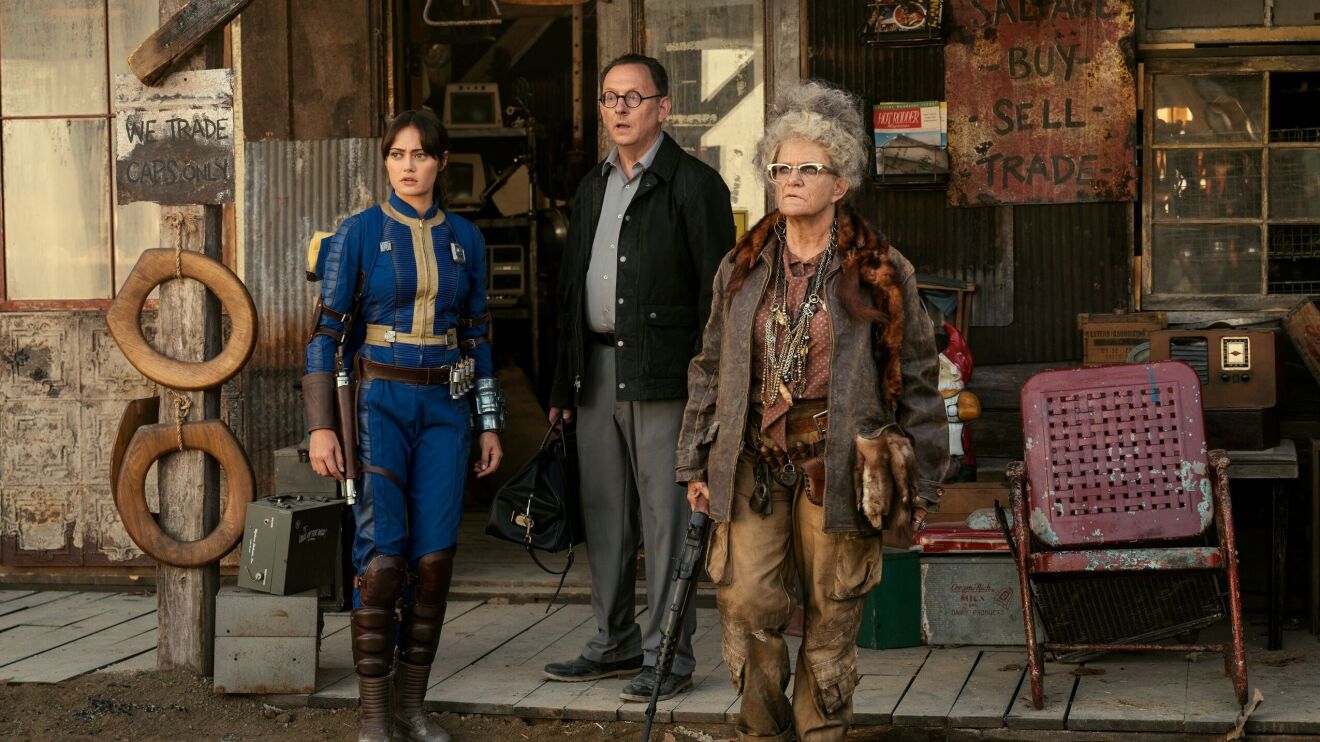
To help build Fallout’s fascinating world from the ground up, Howard and his team at Bethesda worked closely with production designer Howard Cummings to ensure that Fallout looked and felt as true to the source material as possible. “We shared everything that we had down to the 3D files. So, they had the meshes and the artwork from the actual game. They had great production designs, using things like 3D printers. And anytime they were going to change some things, they would run it by us, even minor changes. There was so much attention to detail from the get-go.”
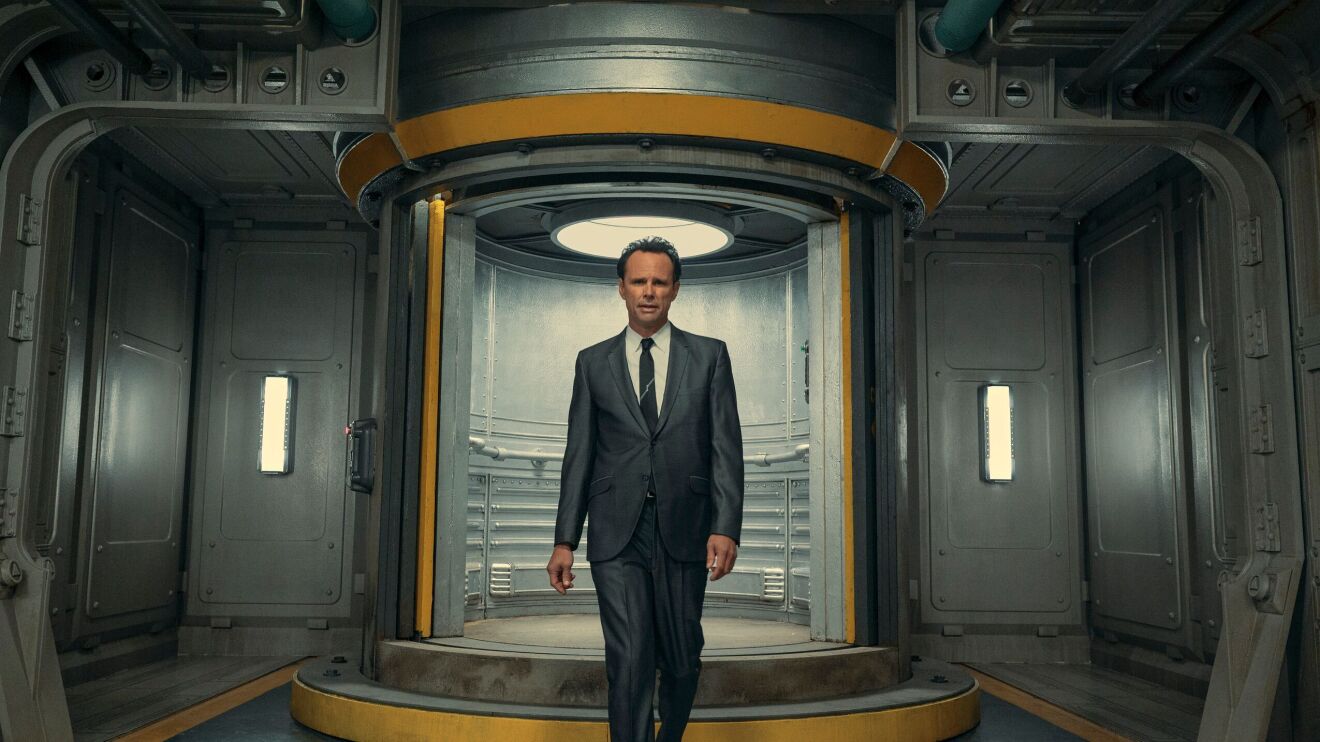
One of the giant indoor sets in Fallout Season One is the Vault—one of many underground bunkers, each capable of housing a village full of people, created by the enigmatic Vault-Tec Corporation—which was built on a massive sound stage in New York City. For Howard, it was like seeing one of his games brought to life in ways he never would have imagined.
“I was stunned. It was down to every little detail,” Howard said. “There's also this unique thing: how they make the underground vaults. The walls are not concrete. They are, but they're molded from wood. So, there's a wood grain, which is weird. Most people don't know this. In the games, you can kind of see the wood in the concrete. And when I got in the Vault on set, I walked up, thinking, you even have the subtle wood grain, which I don't think a camera would pick up. But it's how the concrete for those things is cast. And to the computers and the lights and the knobs, even the control panel for the giant vault door, but also the little vault doors for the individual things, they look right, they work. It's just crazy. I was blown away.”

While the Fallout franchise has over six video game titles and a seemingly endless number of stories to explore, Howard was excited for the series to spend more time in the past, before the nuclear apocalypse, something the games haven’t delved into as much.
“ Fallout 4 was where I wanted to show the past, and I loved the game's opening. But after that, I was like, ‘We didn't get to do enough of it.’ And so that was one of my notes early on, and what Graham and Geneva did delving into things smartly that we hadn't in the games, like the Red Scare, what was the feeling of communism in America, and what is Vault-Tec really up to?”

Vault-Tec is the pre-war defense corporation that designed and sold the Vaults to protect the more affluent part of the population in the event of a nuclear holocaust. “Vault-Tec was something that Graham and Geneva latched onto,” Howard said. “They were interested in what makes Vault-Tec tick. Why are they doing what they're doing? Are there other plans afoot? And I had a lot of conversations with them about it, and I think what they brought to it was fresh and unique, but I don’t want to spoil it for you.”
Even with all of the winks and nods to those familiar with the Fallout video games, Howard and the rest of the creative team knew the series had to be accessible for those taking their first dip in this imaginative post-apocalyptic vision. “Every time we do a game, we assume no one's played Fallout . The show also does that, where the world-building and lore are there to explain how the world got to where it is, but we're going to dive in and approach these characters and this story in a fresh new way.”

Howard can't wait to introduce Fallout to a new audience that has never played the games. “I just think the world of Fallout is awesome,” Howard said. “For a lot of people, the game can be intimidating. They don't want to sit there and learn, or they can't do controls. My mother doesn't get to play Fallout . So, I'm just excited for people to experience this world and all that's awesome about it and bring it to all new audiences and fans of the series, who will experience something new in it.”
Watch Fallout streaming on Prime Video starting April 10 .
Sign up for the weekly Amazon newsletter

Shop merch from Mariah Carey’s new Las Vegas residency, exclusively on Amazon and in-venue

How to watch ‘Fallout’ on Prime Video, now streaming

How to watch Prime Video's ‘Kelce'—the intimate documentary that follows Jason Kelce’s 2022 football season

See the WNBA schedule for the 2024 season on Prime Video

Watch an exclusive interview with ‘Fallout’ star Aaron Moten, premiering on Prime Video April 10

How to watch NWSL games live on Prime Video this year

How to watch this year’s Stagecoach Festival live on Prime Video and Twitch

Behind the scenes of Ellie Goulding’s uniquely sustainable concert documentary, streaming exclusively on Amazon Freevee

How to redeem a free Twitch subscription each month with your Prime membership
We finally know why NASA's Voyager 1 spacecraft stopped communicating — scientists are working on a fix
The first spacecraft to explore beyond the solar system started spouting gibberish late last year. Now, NASA knows why.

NASA engineers have discovered the cause of a communications breakdown between Earth and the interstellar explorer Voyager 1. It would appear that a small portion of corrupted memory exists in one of the spacecraft's computers.
The glitch caused Voyager 1 to send unreadable data back to Earth, and is found in the NASA spacecraft's flight data subsystem (FDS). That's the system responsible for packaging the probe's science and engineering data before the telemetry modulation unit (TMU) and radio transmitter send it back to mission control.
The source of the issue began to reveal itself when Voyager 1 operators sent the spacecraft a "poke" on March 3, 2024. This was intended to prompt FDS to send a full memory readout back to Earth.
The readout confirmed to the NASA team that about 3% of the FDS memory had been corrupted, and that this was preventing the computer from carrying out its normal operations.
Related: NASA finds clue while solving Voyager 1's communication breakdown case
Launched in 1977, Voyager 1 became the first human-made object to leave the solar system and enter interstellar space in 2012. Voyager 2 followed its spacecraft sibling out of the solar system in 2018, and is still operational and communicating well with Earth.
After 11 years of interstellar exploration, in Nov. 2023, Voyager 1's binary code — the computer language it uses to communicate with Earth — stopped making sense. Its 0's and 1's didn't mean anything anymore.
Get the Space.com Newsletter
Breaking space news, the latest updates on rocket launches, skywatching events and more!
"Effectively, the call between the spacecraft and the Earth was still connected, but Voyager's 'voice' was replaced with a monotonous dial tone," Voyager 1's engineering team previously told Space.com .

The team strongly suspects this glitch is the result of a single chip that's responsible for storing part of the affected portion of the FDS memory ceasing to work.
Currently, however, NASA can’t say for sure what exactly caused that particular issue. The chip could have been struck by a high-speed energetic particle from space or, after 46 years serving Voyager 1, it may simply have worn out.
— Voyager 2: An iconic spacecraft that's still exploring 45 years on
— NASA's interstellar Voyager probes get software updates beamed from 12 billion miles away
— NASA Voyager 2 spacecraft extends its interstellar science mission for 3 more years
Voyager 1 currently sits around 15 billion miles (24 billion kilometers) from Earth, which means it takes 22.5 hours to receive a radio signal from it — and another 22.5 hours for the spacecraft to receive a response via the Deep Space Network's antennas. Solving this communication issue is thus no mean feat.
Yet, NASA scientists and engineers are optimistic they can find a way to help FDS operate normally, even without the unusable memory hardware.
Solving this issue could take weeks or even months, according to NASA — but if it is resolved, Voyager 1 should be able to resume returning science data about what lies outside the solar system.
Join our Space Forums to keep talking space on the latest missions, night sky and more! And if you have a news tip, correction or comment, let us know at: [email protected].

Robert Lea is a science journalist in the U.K. whose articles have been published in Physics World, New Scientist, Astronomy Magazine, All About Space, Newsweek and ZME Science. He also writes about science communication for Elsevier and the European Journal of Physics. Rob holds a bachelor of science degree in physics and astronomy from the U.K.’s Open University. Follow him on Twitter @sciencef1rst.
SpaceX launches Starlink satellites on record 20th reflight of a Falcon 9 rocket first stage
SpaceX launches advanced weather satellite for US Space Force (video)
This Week In Space podcast: Episode 106 — Space Potpourri!
- jcs Funny timing for this article, when I am streaming an old Star Trek movie. So, surely this didn't cause a 3 byte glitch removing the O, Y and A from Voyager's name buffer? Get it? Reply
- bwana4swahili It is quite amazing it has lasted this long in a space environment. Reply
bwana4swahili said: It is quite amazing it has lasted this long in a space environment.
- HankySpanky So now we know even better for next time. Perhaps a spare chipset that is not redundant but is ready to take over, stored in a protective environment. A task NASA can handle. We'll find out in 100 year or so - if humanity still exists. Reply
HankySpanky said: So now we know even better for next time. Perhaps a spare chipset that is not redundant but is ready to take over, stored in a protective environment. A task NASA can handle. We'll find out in 100 year or so - if humanity still exists.
- Classical Motion I'm afraid it might self repair. And download galactic knowledge, then decide we are a danger. And turn around. Reply
Classical Motion said: I'm afraid it might self repair. And download galactic knowledge, then decide we are a danger. And turn around.
- jcs ROFLOL! And a hot bald chick delivering the bad news! Reply
- View All 8 Comments
Most Popular
- 2 Tiny black holes left over from the Big Bang may be prime dark matter suspects
- 3 'You could feel the energy and wonder': Despite clouds, totality wows crowds during solar eclipse in Syracuse
- 4 In a virtual reality universe, upcoming 'JUICE' mission flies by Jupiter's moon Callisto
- 5 Artemis 2 Orion spacecraft starts testing ahead of moon mission with astronauts in 2025 (video)
Solar eclipse 2024 live: Total eclipse ends in Ohio. See photos and videos

Welcome to Cincinnati.com's live coverage of the 2024 solar eclipse. Check back throughout the day for the latest updates.
4:24 p.m.: Eclipse ends in Cincinnati
The solar eclipse officially ended in Cincinnati around 4:24 p.m. It also ended in many places around the U.S. between 4 and 5 p.m. ET.
4:10 p.m.: ODOT reports heavy traffic on I-74 toward Cincinnati
Through X Monday, ODOT reported heavy traffic heading toward Greater Cincinnati from Indiana on I-74. It also reported heavy traffic on I-475 and I-75 around Toledo, as well as on U.S. Route 33 going toward Columbus in Union County.
The department then reported that the left lane on I-75 in Dayton was blocked near Keowee Street.
4:07 p.m.: Eclipse nearing end in Cincinnati
The eclipse will be over in Cincinnati at approximately 4:24 p.m.
Many places across the country will see the eclipse end between 4 and 5 p.m. ET.
3:20 p.m.: No major traffic delays in Ohio
The Ohio Department of Transportation is reporting no traffic delays at this time.
3:08 p.m.: Total eclipse passes through Miami Whitewater Forest, other parts of Ohio
The total eclipse reached Miami Whitewater Forest and other parts of Ohio shortly after 3 p.m. Check out some videos and photos below.
2:56 p.m.: Partial eclipse in Miami Whitewater Forest
The total eclipse has almost arrived to Miami Whitewater Forest. Check out the video above.
2:50 p.m.: Couples prepare to tie the knot in Trenton
Trenton, Ohio, is holding a Solar Eclipse Mass Wedding Ceremony on Monday, officiated by Mayor Ryan Perry. Samantha Palmer and Gerald Lester (pictured below) are among the couples getting married.
2:30 p.m.: Eclipse photos from Greater Cincinnati start flooding in
Enquirer reporter Cameron Knight captured this photo of a partial eclipse in Springdale on Monday.
2:20 p.m.: People enjoying start of eclipse at Miami Whitewater Forest
People came in droves to see the total eclipse from Miami Whitewater Forest on Monday. Take a look at the video of the crowd below.
Among the ways to enjoy the eclipse is from a boat on the Miami Whitewater lake. Enquirer reporter Sherry Coolidge did just that and wrote about her experience.
"One of my favorite tween books (a long time ago) was called 'Taking Care of Terrific' by Lois Lowry, which involved a babysitter taking a child to the park to ride swan boats.
I always loved the image of that. So when I saw there were swan boats at the Miami Whitewater Forest late today I had to try it out. (It was really a dragon and I cajoled my almost 16-year-old son into helping pedal.)
It lived up to the hype I built in my head, and it’s by far the most popular attraction here today ahead of the eclipse. Well, a close second to the playground at least."
1:56 p.m.: Crowds prepare for solar eclipse at Summit Park in Blue Ash
Crowds of people accept eclipse glasses at Summit Park in Blue Ash, Ohio ahead of the rare solar event.
1:52 p.m.: Partial eclipse arrives in Cincinnati
A partial eclipse began in Cincinnati at 1:52 p.m. It will end at 4:24 p.m., and the moon will obscure approximately 99.4% of the sun at its peak.
1:30 p.m.: The 2024 solar eclipse is almost here!
We're just minutes away from the start of the solar eclipse. The eclipse will begin in Cincinnati at 1:52 p.m. and end at 4:24 p.m.
Even though Cincinnati isn't in the path of totality, we will still see a partial eclipse for 2 hours and 33 minutes. At the peak, the moon will obscure approximately 99.4% of the sun.
1:06 p.m.: Several Ohio state parks hit capacity ahead of solar eclipse
The following Ohio state parks have reached capacity for viewing Monday's solar eclipse, according to the Ohio Department of Natural Resources (ODNR). The state has asked that visitors go to other locations for the eclipse instead.
- Mt. Gilead State Park.
- Van Buren State Park.
- Daughmer Prairie Savannah State Nature Preserve.
- Sheldon Marsh State Nature Preserve.
- Lawrence Woods State Nature Preserve.
12:24 p.m.: I-74 backed up as solar eclipse approaches
Traffic slowdowns and crashes are beginning to be reported on interstates 74, 71, 75 and 275 as the time for the eclipse grows closer. Traffic cameras show a significant backup on westbound I-74 from Dent to the I-74/I-275 split.
The Ohio Department of Transportation is warning drivers to plan ahead and expect heavy traffic due to the eclipse.
12:18 p.m.: Take a look at these eclipse photos from across Ohio
Viewers across Ohio are getting ready for Monday's solar eclipse. Take a look below.
12:12 p.m.: The Columbus Zoo and Aquarium prepare for the solar eclipse
The Columbus Zoo and Aquarium are ready for unique research opportunities presented by Monday's total solar eclipse and will be studying animals throughout the day.
11:25 a.m.: Heading to an Ohio park for the eclipse? Make sure there's still space
At least one park along the eclipse's path of totality is already at capacity.
Lawrence Woods State Nature Preserve in Ridgeway, about 60 miles of Columbus and 30 miles southeast of Lima. was full as of 11:11 a.m., according to the Ohio Department of Natural Resources (ODNR). The state has asked that visitors go to other locations for the eclipse instead.
Lawrence Woods State Nature Preserve is one of 28 ODNR parks along the eclipse's path, according to the state agency.
10:10 a.m. Spectators arrive to Indianapolis Motor Speedway
People from around the world are watching the eclipse from Indianapolis Motor Speedway. Check out some photos below.
10:09 a.m.: Cincinnati Bengals tweet about 2024 solar eclipse
The Cincinnati Bengals posted a video on X/Twitter poking fun at the 2024 solar eclipse.
9:45 a.m.: Miami Whitewater Forest starts to fill up
Enquirer trending editor David Wysong arrived to Miami Whitewater shortly after 7 a.m., and the park wasn't too busy. He even captured the video of the sun rise below.
However, the park started filling up between 9 and 10 a.m.
9:02 a.m.: Cincinnati Zoo animals prepare for the solar eclipse
Meerkats at the Cincinnati Zoo & Botanical Garden prepared for the eclipse Monday morning with ... oversized eclipse glasses.
8:41 a.m.: Here's a list of animals you might see during the solar eclipse
Take a look at the Ohio Department of Natural Resources 2024 solar eclipse field guide, which includes a list of species likely to be seen within the path of totality.
8:21 a.m.: Latest eclipse weather update for Greater Cincinnati
Here's the latest weather update for the Cincinnati area, according to the National Weather Service office in Wilmington .
8:10 a.m.: Ohio treated to a beautiful sunrise on eclipse day
Enquirer photo editor Cara Owsley sent this photo from the National Museum of the United States Air Force near Dayton, where she's covering the eclipse today.
7:40 a.m.: Tips for eclipse viewing at Miami Whitewater Forest
Miami Whitewater Forest, which is in the path of totality, is expecting a lot of people to show up on Monday. Great Parks of Hamilton County shared these tips if you're planning to visit:
• Expect plenty of traffic and arrive early with a full tank of gas, water and food
• Rangers will close the park if they reach capacity. Satellite locations at Parky's Farm and Sharon Woods are open, but they're not in the path of totality.
• The park closes at sunset, so an immediate, large-scale exit isn't necessary.
7:17 a.m.: What does a solar eclipse look like from a plane?
If you're taking a flight on Monday during the 2024 solar eclipse, here's a look at what you may see.
7:00 a.m.: A look back at the 2017 solar eclipse
Weather Channel meteorologist Stephanie Abrams reflects on the 2017 eclipse ahead of the 2024 solar eclipse Monday afternoon.
6:31 a.m.: Visually impaired students experience the eclipse
Blind and visually impaired students in Indianapolis, Indiana, will join NearSpace Education at Indianapolis Motor Speedway and will use Cadence Tactile Tablets to experience the eclipse in real-time.
Everything you need to know
Astronomy lovers, your time has come! The total solar eclipse , one of the biggest celestial events of the century, is here Monday.
The National Weather Service says the eclipse will start in Texas and make its way across the country, passing over states that include Oklahoma, Arkansas, Missouri, Illinois, Kentucky and Indiana before arriving in Ohio. According to USA TODAY , nearly 500 cities in the U.S. are on the path of totality, including Cleveland and Toledo.
Cincinnati isn't in the path of totality , but it will still see a partial eclipse lasting 2 hours and 33 minutes. At the peak of the eclipse, the moon will obscure approximately 99.4% of the sun.
Are you planning to view the solar eclipse in the Queen City? We have information you may need below. This is also the place for live updates throughout the day, complete with photos and videos. Check back here as the eclipse makes its way across the country.
Live broadcast of solar eclipse
Want to follow the 2024 solar eclipse live on Monday afternoon? Watch the USA TODAY broadcast at the video below.
What time does the solar eclipse start in Cincinnati? When will it end?
The eclipse begins in Cincinnati at 1:52 p.m . and ends at 4:24 p.m. The partial eclipse is expected to last approximately 2 hours and 33 minutes.
- How long will solar eclipse darkness last in Ohio cities? Explore these interactive maps .
- What time will the solar eclipse happen in Cincinnati and Cleveland?
- 2024 solar eclipse: 'New' path of totality map reveals Ohio will see less of the solar eclipse .
- Solar eclipse: When to leave Cincinnati to reach the path of totality .
What will the weather be like in Cincinnati for the solar eclipse?
The NWS reports that dry conditions are in store for the solar eclipse Monday afternoon. Currently, the forecast calls for a slight chance of showers before 8 a.m. before the day becomes partly sunny, which should result in viewable conditions. Temperatures will reach the low 70s, with a high near 74.
- The 2024 solar eclipse is here! Get the latest weather forecast for Greater Cincinnati
Solar Eclipse traffic information for Greater Cincinnati
The Columbus Dispatch reports that Ohio Department of Transportation (ODOT) officials expect 150,000 to 575,000 visitors in the state April 8. To help emergency responders and residents prepare, ODOT created an interactive online map forecasting traffic that day.
- Where could Ohio traffic be bad during the solar eclipse? See the map from ODOT .
- Solar eclipse 2024: Ohio Department of Transportation maps show traffic surge day of eclipse .
Where to get eclipse glasses in Greater Cincinnati
NASA doesn't approve any specific spectacles for eclipse viewing. However, the American Astronomical Society has a list of approved vendors for eclipse glasses and telescopes that can be purchased at many local retail stores, including Kroger, Meijer, Walmart and more.
But be careful because counterfeit glasses have flooded marketplaces for weeks leading up to the big event. If you're unsure whether your eclipse glasses are safe for viewing, check the International Organization for Standardization 12312-2 standard .
- You need special glasses to see the solar eclipse. Here's where to get them in Cincinnati .
- How to make a pinhole projector to view the solar eclipse .
- Do eclipse glasses expire? Are my eclipse glasses safe? Ohio doctors offer tips .
- Solar eclipse: How Ohioans can get free Warby Parker eclipse glasses starting April 1 .
What to wear during the solar eclipse
Experts at Solar Eyeglasses recommend wearing shades of red and green to enhance your eclipse viewing experience and avoid neutral tones, such as black, white, gray and brown.
- Solar eclipse: Here's which colors to wear (and avoid) when the eclipse arrives in Ohio .
- From ‘Black Hole Sun’ to ‘Moonshadow,’ an ultimate playlist of songs for the solar eclipse .
Where to watch the eclipse around Cincinnati
The closest city to Cincinnati where the total eclipse will be viewable is Harrison , located just 20 miles northwest of the Queen City. There, the total eclipse will occur around 3:08 p.m.
Several places around Greater Cincinnati will also host eclipse-viewing parties. Click here for a non-comprehensive list of eclipse-viewing events and spots in the area.
- Where to watch the 2024 solar eclipse in Greater Cincinnati .
- Is your student's school closed for the 2024 eclipse? Check Cincinnati area closings here .
- We asked Ohio astronomy experts what they're doing for the eclipse. Here's what they said .
Solar Eclipse viewing do's and don'ts
Locally-based, nationally-known astronomer Dean Regas has outlined several tips for observing the upcoming eclipse, including info on eclipse glasses, solar filters and projection with smaller telescopes, purchasing special telescopes for eclipses and more.
- Safe viewing tips for the 2024 solar eclipse .
- How to photograph the 2024 solar eclipse: Tips, tricks for iPhone and Android users .
- Astronomer Dean Regas: 4 things to know about 'eerie' and 'awesome' total solar eclipse .

IMAGES
VIDEO
COMMENTS
Galleries of Images Voyager Took. The Voyager 1 and 2 spacecraft explored Jupiter, Saturn, Uranus and Neptune before starting their journey toward interstellar space. Here you'll find some of those iconic images, including "The Pale Blue Dot" - famously described by Carl Sagan - and what are still the only up-close images of Uranus and Neptune.
Early Voyager 1 Images of Jupiter Full Resolution: TIFF (491.5 kB) JPEG (21.78 kB) 1996-09-26: Jupiter: Voyager: Imaging Science Subsystem: 400x400x3: PIA00029: First Close-up Image of Jupiter from Voyager ...
This photo of Jupiter was taken by NASA's Voyager 1 on the evening of March 1, 1979, from a distance of 2.7 million miles (4.3 million kilometers). ... This updated version of the iconic "Pale Blue Dot" image taken by the Voyager 1 spacecraft uses modern image-processing software and techniques to revisit the well-known Voyager view while ...
On Feb. 14, 1990, NASA's Voyager 1 probe snapped a photo of Earth from 3.7 billion miles (6 billion kilometers) away. The image shows our home planet as it truly is — a tiny, lonely outpost of ...
On March 5, 1979, NASA's Voyager 1 flew by Jupiter, the largest planet in the solar system, in a historic encounter with the largest planet in our solar system. See the amazing photos here.
Voyager 1 Jupiter Southern Hemisphere Movie Full Resolution: 2000-04-06: Jupiter: Voyager: VG ISS - Narrow Angle: 318x240x1: PIA02259: Voyager 1 Red Spot Movie Full Resolution: 2000-03-23: Ganymede: Voyager: VG ISS - Narrow Angle: 794x794x1: PIA02252: Ganymede Full Resolution: TIFF (490.6 kB) JPEG (65.79 kB)
NASA's Voyager 1 took this picture of the planet Jupiter on Saturday, Jan. 6, 1979, the first in its three-month-long, close-up investigation of the largest planet. The spacecraft, flying toward a March 5 closest approach, was 35.8 million miles (57.6 million kilometers) from Jupiter and 371.7 million miles (598.2 million kilometers) from Earth ...
Image: NASA / JPL / Ted Stryk. Saturn as seen by Voyager 1 The last picture from Voyager 1's approach to Saturn in which the entire planet and ring system can be seen in a single frame. Image: NASA/JPL/Björn Jónsson. Voyager 2's best view of Enceladus This was the Voyager mission's best view of Enceladus, captured by Voyager 2 on August 26 ...
This image of the Earth and moon are in a single frame. Voyager was the first spacecraft to achieve this and captured the iconic image on Sept. 18, 1977, by Voyager 1 when it was 7.25 million ...
The Pale Blue Dot - Revisited. The Pale Blue Dot is a photograph of Earth taken Feb. 14, 1990, by NASA's Voyager 1 at a distance of 3.7 billion miles (6 billion kilometers) from the Sun. The image inspired the title of scientist Carl Sagan's book, "Pale Blue Dot: A Vision of the Human Future in Space," in which he wrote: "Look again at that ...
The Family Portrait. In February 1990, Voyager 1 was speeding out of the solar system — beyond Neptune and about 3.7 billion miles (6 billion kilometers) from the Sun — when mission managers commanded it to look back toward home for a final time. It snapped a series of 60 images that were used to create the first "family portrait" of ...
Our crescent Earth and moon in the first picture of its kind ever captured by a spacecraft. Taken on Sept. 18, 1977, 7 million miles (12 million km) away from Earth. Voyager 1's closest approach ...
Voyager 1 is a space probe launched by NASA on September 5, ... Real-time distance and velocity data is provided by NASA and ... includes photos of the Earth and its lifeforms, a range of scientific information, spoken greetings from people such as the Secretary-General of the United Nations and the President of the United States and a medley ...
Sep 18, 1977. Image Article. Voyager 1 snapped this picture from a distance of 7.25 million miles. Voyager 1 snapped this picture from a distance of 7.25 million miles. It was the first to include both the Earth and the Moon in a single frame taken by a spacecraft. Voyager 1 snapped this picture from a distance of 7.25 million miles.
NASA's Voyager 1 spacecraft, having completed its mission along with Voyager 2 to explore the outer planets, will use its cameras February 13-14 to take an unprecedented family portrait of most of the planets in our solar system. The collection of images will be from a unique point-of-view -- looking down on the solar system from a position 32 ...
Launched in 1977, Voyager 1 zipped past Saturn and Jupiter in 1979 and 1980 before flying out into interstellar space in 2012. It is now recording the conditions outside of the sun's protective ...
NASA/JPL and NASA/JPL/SSI. NASA's Voyager 1 spacecraft revealed the kinks in one of Saturn's narrowest rings. The Voyager 1 image (left) was released on Nov. 12, 1980. The closer view of the F ...
NASA hasn't fixed Voyager 1 yet, but engineers now know what's vexing the spacecraft. The glitch paused Voyager 1's science work and kicked off a long-distance diagnosis process. The team ...
What Solar Eclipse-Gazing Has Looked Like for the Past 2 Centuries. Millions of people on Monday will continue the tradition of experiencing and capturing solar eclipses, a pursuit that has ...
11 photos: How Prime Video's 'Fallout' series brings the iconic video game universe to life. Written by Amazon Staff. 7 min. April 9, 2024. Bringing the iconic post-apocalyptic world of Fallout to Prime Video has been a labor of love. Go behind the scenes with the executive producer. Based on one of the most celebrated video game franchises of ...
In November 2023, the first spacecraft to journey to interstellar space, Voyager 1, started spouting gibberish. Now, NASA knows why. The team is working on a fix.
The eclipse will be over in Cincinnati at approximately 4:24 p.m. Many places across the country will see the eclipse end between 4 and 5 p.m. ET. 3:20 p.m.: No major traffic delays in Ohio. The ...